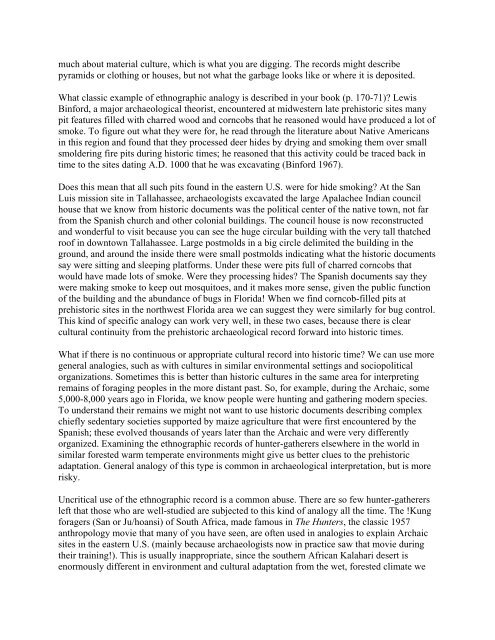INTRODUCTION TO ARCHAEOLOGY Nancy White - Touro Institute
INTRODUCTION TO ARCHAEOLOGY Nancy White - Touro Institute
INTRODUCTION TO ARCHAEOLOGY Nancy White - Touro Institute
Create successful ePaper yourself
Turn your PDF publications into a flip-book with our unique Google optimized e-Paper software.
much about material culture, which is what you are digging. The records might describe<br />
pyramids or clothing or houses, but not what the garbage looks like or where it is deposited.<br />
What classic example of ethnographic analogy is described in your book (p. 170-71)? Lewis<br />
Binford, a major archaeological theorist, encountered at midwestern late prehistoric sites many<br />
pit features filled with charred wood and corncobs that he reasoned would have produced a lot of<br />
smoke. To figure out what they were for, he read through the literature about Native Americans<br />
in this region and found that they processed deer hides by drying and smoking them over small<br />
smoldering fire pits during historic times; he reasoned that this activity could be traced back in<br />
time to the sites dating A.D. 1000 that he was excavating (Binford 1967).<br />
Does this mean that all such pits found in the eastern U.S. were for hide smoking? At the San<br />
Luis mission site in Tallahassee, archaeologists excavated the large Apalachee Indian council<br />
house that we know from historic documents was the political center of the native town, not far<br />
from the Spanish church and other colonial buildings. The council house is now reconstructed<br />
and wonderful to visit because you can see the huge circular building with the very tall thatched<br />
roof in downtown Tallahassee. Large postmolds in a big circle delimited the building in the<br />
ground, and around the inside there were small postmolds indicating what the historic documents<br />
say were sitting and sleeping platforms. Under these were pits full of charred corncobs that<br />
would have made lots of smoke. Were they processing hides? The Spanish documents say they<br />
were making smoke to keep out mosquitoes, and it makes more sense, given the public function<br />
of the building and the abundance of bugs in Florida! When we find corncob-filled pits at<br />
prehistoric sites in the northwest Florida area we can suggest they were similarly for bug control.<br />
This kind of specific analogy can work very well, in these two cases, because there is clear<br />
cultural continuity from the prehistoric archaeological record forward into historic times.<br />
What if there is no continuous or appropriate cultural record into historic time? We can use more<br />
general analogies, such as with cultures in similar environmental settings and sociopolitical<br />
organizations. Sometimes this is better than historic cultures in the same area for interpreting<br />
remains of foraging peoples in the more distant past. So, for example, during the Archaic, some<br />
5,000-8,000 years ago in Florida, we know people were hunting and gathering modern species.<br />
To understand their remains we might not want to use historic documents describing complex<br />
chiefly sedentary societies supported by maize agriculture that were first encountered by the<br />
Spanish; these evolved thousands of years later than the Archaic and were very differently<br />
organized. Examining the ethnographic records of hunter-gatherers elsewhere in the world in<br />
similar forested warm temperate environments might give us better clues to the prehistoric<br />
adaptation. General analogy of this type is common in archaeological interpretation, but is more<br />
risky.<br />
Uncritical use of the ethnographic record is a common abuse. There are so few hunter-gatherers<br />
left that those who are well-studied are subjected to this kind of analogy all the time. The !Kung<br />
foragers (San or Ju/hoansi) of South Africa, made famous in The Hunters, the classic 1957<br />
anthropology movie that many of you have seen, are often used in analogies to explain Archaic<br />
sites in the eastern U.S. (mainly because archaeologists now in practice saw that movie during<br />
their training!). This is usually inappropriate, since the southern African Kalahari desert is<br />
enormously different in environment and cultural adaptation from the wet, forested climate we
















